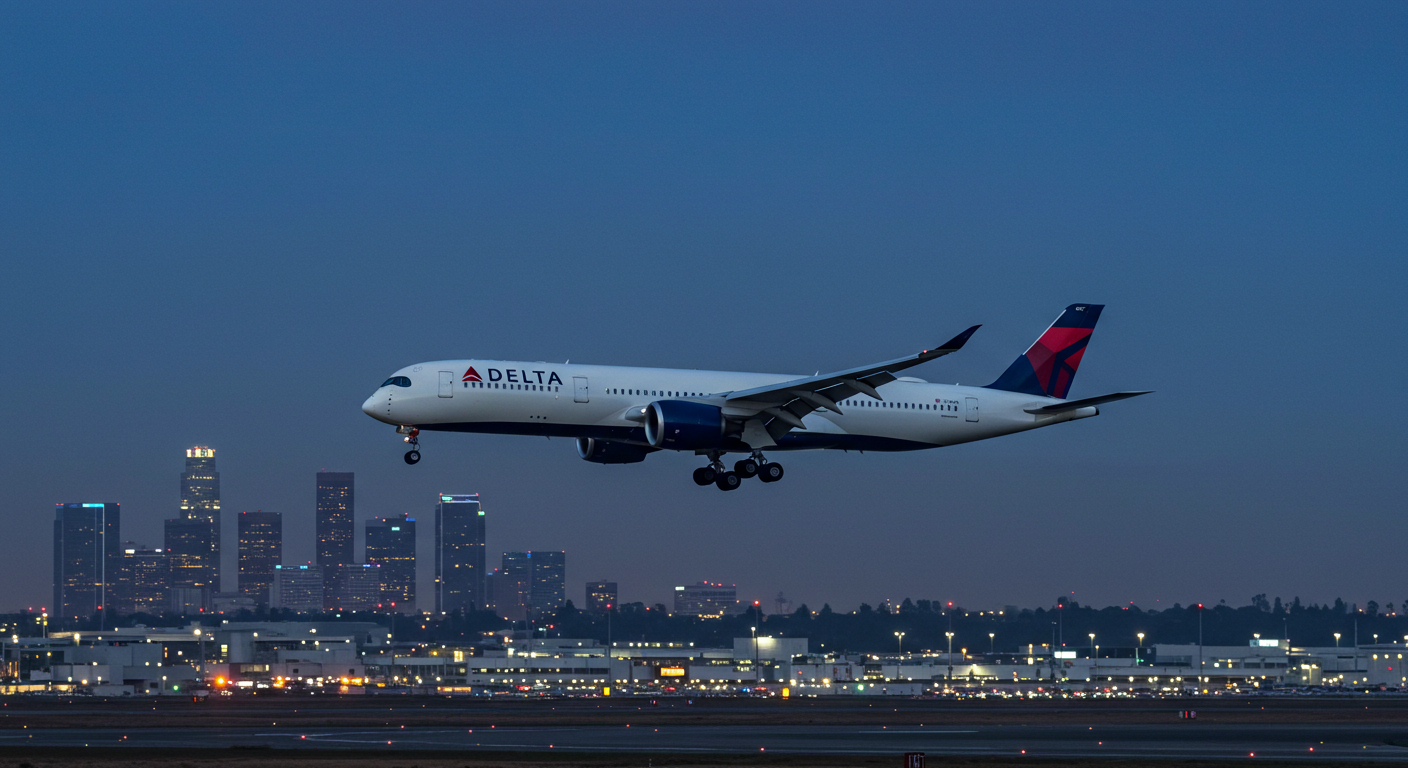Imagine you are thousands of feet above the vast Pacific Ocean, on a long journey across continents. Suddenly, your flight takes an unexpected turn, disrupting your peaceful voyage. This is exactly what happened to passengers on Delta Flight DL275. This flight, originally headed for Tokyo, was forced to divert to Los Angeles due to a technical issue that required immediate attention. The incident, while safely managed, highlights critical aspects of aviation safety, the significant financial impact of such events, and the exciting potential of new technologies to prevent them in the future.
Beyond the Headline: Why This Story Matters
The story of Delta Flight DL275 diverted to LAX is more than just a news headline; it’s a deep dive into the complexities of modern air travel and the systems that keep it functioning. We will explore what happened, how Delta responded, the surprising costs involved, and how cutting-edge technology could change the future of flying across the globe.
The Unexpected Turn: What Happened to Delta Flight DL275?
A Routine Journey Interrupted
Every flight begins with a plan, a route, and an expected arrival at its final destination. However, sometimes, the unexpected happens despite all preparations.
Delta Air Lines Flight DL275 began its journey as a routine trans-Pacific flight with no initial complications. It departed from Detroit Metropolitan Wayne County Airport (DTW) with its destination set for Tokyo Haneda (HND). The date was May 28, 2025, and the skies seemed favorable for travel.
The aircraft involved was an advanced Airbus A350-900, specifically registered as N508DN, part of Delta’s modernized fleet. This type of aircraft is known for its modern design, long-range efficiency, and passenger comfort.
The Engine’s Anti-Ice System Issue
Mid-flight, while cruising at about 38,000 feet over the North Pacific, the crew detected a problem through their monitoring systems. The issue was with the anti-ice system of one of its Rolls-Royce Trent XWB engines—an essential safety feature.
This anti-ice system is incredibly important for maintaining safe engine operation. It prevents ice from building up on engine parts, especially when flying at high altitudes where temperatures are extremely cold. Without it working correctly, continuing the flight could have become dangerously risky.
The Decision to Divert to LAX
Faced with this technical malfunction, the flight crew made a crucial decision: to reroute to Los Angeles International Airport (LAX), a major West Coast hub. This was a strategic and safety-driven choice.
LAX is a major Delta hub, meaning it has extensive maintenance facilities and experienced personnel ready to handle such situations effectively. The aircraft landed safely on Runway 06R approximately 5.5 hours after the diversion decision was made. Importantly, no injuries were reported among the passengers or crew, and the landing was smooth.
Delta’s Swift Response and Passenger Experience
Prioritizing Safety and Support
When an unexpected event like a diversion occurs, an airline’s response is critical to both safety and reputation. Delta’s actions focused on immediate safety, timely communication, and passenger care.
Delta’s immediate response to the DL275 incident showed their commitment to both technical and emotional support for travelers. The airline quickly communicated the technical issue to passengers in-flight and on the ground. They also promptly rebooked passengers on other flights to Tokyo Haneda and provided necessary ground support, meals, and accommodations as needed.
After landing, the Airbus A350 remained on the ground for about 18.5 hours. This time was used for thorough checks, inspections, and repairs before the aircraft was cleared to fly again by maintenance crews.
The Passenger’s Journey: From Calm to Concerned
For passengers, a mid-flight diversion can be a mix of emotions and confusion. The atmosphere can shift quickly from calm to concerned as the situation unfolds in real-time. There’s the initial uncertainty, then the relief of a safe landing, followed by the inconvenience of rebooking and unexpected delays.
While specific passenger stories from this particular Delta Flight DL275 diverted LAX incident are not widely available in the media, we can imagine the typical experience based on similar events. Passengers often face unplanned layovers, missed connections, and the disruption of their carefully arranged travel plans. Airlines work to minimize this inconvenience, but the human element of such events is always significant and emotionally taxing.
The Hidden Costs of a Diversion: More Than Just a Detour
A $2.3 Million Price Tag
The DL275 diversion came with a hefty price tag for Delta: an estimated $2.3 million in total financial impact. This figure includes various direct and indirect costs incurred by the airline.
A significant portion of this cost, about $180,000, was due to the unplanned 12+ hours of additional flight time, mainly for extra fuel and operational adjustments. However, the biggest impact was the estimated $1.9 million in lost ticket revenue from the Tokyo segment, which had to be canceled or rebooked.
Why Diversions Are So Expensive
While the average long-haul diversion costs airlines around $127,000, complex incidents like DL275 can be much more expensive due to scale. This is because they involve longer flight times, wide-body aircraft, and premium international routes with many logistical complications.
The financial impact extends beyond immediate operational expenses. It includes complex logistics like securing new bookings, arranging accommodations for affected passengers, compensations, and ensuring all safety and compliance standards are met. This highlights a major challenge for airlines: balancing the absolute need for safety with operational efficiency and long-term profitability.
Technology to the Rescue: Preventing Future Incidents
The Power of Predictive Analytics
What if such costly incidents could be avoided entirely? Advanced technology offers a promising solution for the aviation industry.
Predictive analytics, a type of advanced AI-driven system, could have detected the anti-ice system failure on DL275 hours before takeoff. This early warning could have triggered pre-flight maintenance checks and prevented the diversion altogether.
These technologies offer impressive benefits for airlines. They can lead to a 35% reduction in unplanned maintenance events and annual savings of $18 million in fuel optimization. Furthermore, they can improve on-time performance for long-haul routes by 89% and decrease engine-related diversions by 67%, according to aviation analytics data.
Next-Gen Aviation Tech: A Glimpse into the Future
Specific technological advancements are making this proactive future possible. 5G connectivity, for example, allows for immediate alert generation with sub-millisecond latency. It also supports thousands of aircraft sensors through massive IoT (Internet of Things) connectivity and provides enhanced bandwidth for sending large amounts of aircraft health data to ground stations.
Additionally, advanced materials with self-monitoring capabilities are being developed. These include carbon nanotube sensors built directly into aircraft structures and self-healing materials that can automatically repair minor damage in flight. These innovations are transforming aviation safety from a reactive response to a proactive, preventative strategy for all future flights.
Broader Lessons for the Skies Ahead
A Day of Challenges for Delta
May 28, 2025, seemed to be a particularly challenging day for Delta. The DL275 diversion was not the only incident under the spotlight. On the same day, Delta Flight DL2346 from New York LaGuardia (LGA) to Miami (MIA) diverted to JFK after a loud noise during takeoff, which alarmed passengers and crew.
Also, Flight DL2286 from New York (JFK) to Atlanta (ATL) diverted to Charlotte Douglas Airport (CLT) due to smoke in the cockpit—another safety-first decision. While these incidents had different causes, their timing highlights the constant vigilance required in airline operations and the resilience a major carrier needs to manage multiple challenges simultaneously.
Beyond Technical Glitches: Other Diversion Reasons
Flight diversions aren’t always due to technical malfunctions or mechanical failure. Just two days before DL275, on May 26, 2025, Delta Flight DL694 from Detroit (DTW) to Los Angeles (LAX) diverted to Minneapolis (MSP) because a sick dog in the cabin needed urgent medical attention—a rare but compassionate cause.
Other non-technical diversions can involve unruly passengers or even unexpected animal encounters like snakes or mice on board. This shows that airlines must be prepared for a wide range of unforeseen circumstances, including those related to the well-being of everyone (and everything) on board.
Conclusion: Charting a Safer Course
The diversion of Delta Flight DL275 diverted to LAX serves as a compelling case study in modern aviation. It reminds us of the inherent complexities of long-haul flights and the unwavering commitment to safety required from airlines in today’s world.
Delta’s professional handling of the incident—from the crew’s decisive action mid-air to the ground support at LAX—ensured a safe outcome for everyone. However, the significant financial cost of such events underscores the immense value that advanced technologies, like predictive analytics and smart materials, can bring to the industry. These innovations promise to transform aviation safety from a reactive measure to a proactive strategy, making air travel even more reliable and secure in the future for passengers worldwide.
What do you think is the most important step for airlines to take next to enhance safety and efficiency? Share your thoughts!

